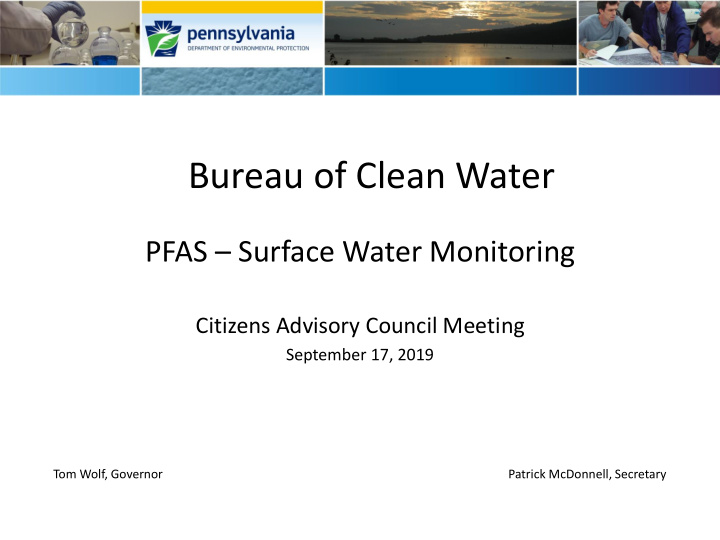



Bureau of Clean Water PFAS – Surface Water Monitoring Citizens Advisory Council Meeting September 17, 2019 Tom Wolf, Governor Patrick McDonnell, Secretary
Bureau of Clean Water - PFAS • Currently, there is no guidance from EPA regarding surface water quality standards for PFAS compounds. • Currently, there is no implementation of water quality standards through permitting or assessment of surface waters. • While there is some localized PFAS surface water data, there is no statewide, comprehensive dataset to inform the development and implementation of a statewide monitoring strategy, water quality standards, assessment methods or permitting.
Bureau of Clean Water - PFAS • Limited guidance from EPA regarding PFAS compounds related wastewater. • Presentation will address two areas DEP Bureau of Clean Water is currently addressing: • Biosolids • Water Quality Monitoring
PFAS in Biosolids • PFAS is typically found in biosolids • Minimal information on quantities of PFAS in biosolids • Minimal research on fate and transport of PFAS in biosolids that are land applied • EPA working on method for quantifying PFAS in biosolids, wastewater and soil matrices • Pilot testing of biosolids treatment for PFAS • Incineration at 1000 o C
PFAS in Biosolids - EPA • CWA Requirements – Review of biosolids regs every 2 years – Goal of report – Identify additional pollutants of concern • EPA OIG Report – Reporting obligation is unfulfilled – EPA program response • 352 unregulated pollutant in biosolids (includes PFAS) • Completion of risk assessment and recommendation on additional pollutants by 12/31/2022 • Any new PFAS Fed biosolids requirements should be incorporated into PA biosolids Regs
Monitoring or Data Collection • Data Collection Protocol Development • Water Quality Standards Development • Assessment Method Development • Permitting and Compliance • Protected Use Assessments • Monitor Temporal Water Quality Trends
Water Quality Network (WQN)
WQN - Objectives • Monitor temporal water quality trends in major surface waters throughout the state • Monitor temporal water quality trends in reference waters • Monitor the trends of nutrient and sediment loads in the major tributaries entering the Chesapeake Bay • Monitor temporal water quality trends in Pennsylvania lakes
WQN Data • Chemical • Metals and Ions • Nutrients • “Emerging Contaminants” • Biological • Benthic Macroinvertebrates • Fishes • Algal Communities • Physical • Habitat • Flow/Discharge
Emerging Contaminants Contaminants of emerging concern (CECs) are those that were either not detected previously or are now found in higher concentrations than the past (https://www.wqa.org/Whats-in-Your-Water/Emerging-Contaminants). They are NOT necessarily “new” compounds. These include many categories of chemicals.
WQN – Emerging Contaminants • Hormones • Wastewater Compounds • Pharmaceuticals • Pesticides • PCBs – Polychlorinated biphenyls • PBDEs – Polybrominated diphenyl ethers • PAHs - Polycyclic Aromatic Hydrocarbons
WQN – Emerging Contaminants • Surface Water Samples • Sediment Samples • Passive Sampler Deployment
WQN - PFAS • Single surface water collection at each of the 178 WQN station locations
WQN - PFAS • 21 passive samplers deployments that will include PFAS
WQN - PFAS • All PFAS surface water samples and passive sampler membranes will be analyzed by SGS AXYS Analytical Services for analysis (Sidney, British Columbia, Canada) • 33 compounds, including: • GenX, ADONA, both fractions of F-53B and total oxidizable precursors (TOP) • Replicate samples will be sent to USGS – National Water Quality Laboratory in Denver and the PA DEP Laboratory in Harrisburg • Results will inform future data collection strategies and potentially inclusion of the PFAS analytical suite as a routine water quality monitoring and assessment objective
Josh Lookenbill, Group Manager Bureau of Clean Water Water Quality Division Monitoring Section 717-783-2959 mlookenbil@pa.gov
Recommend
More recommend